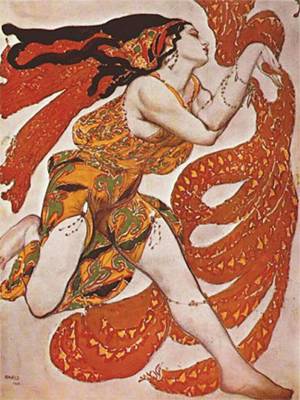
ART/Groningen (NL)
Diaghilev Festival
Jan. 26-30, 2005
The Diaghilev Festival brings together the work of visual artists, composers and choreographers who worked with ballet impresario Sergei Diaghilev (1872-1929).
On concurrent display, 230 paintings, décor and costume designs, drawings, and costumes for works commissioned by Diaghilev for the Ballets Russes.
The Diaghilev exhibition presents work by Picasso, Matisse, de Chirico, Bakst, Benois, Golovin, Serov, Vrubel, Gontcharova, and Larionov, among others.
Born to privilege, Diaghilev started working with visual artists in 1898, with the founding of arts journal “Mir Iskusstva.”
He worked with a large group of visual artists to supply material for his journal, and started presenting their work in exhibitions he organized in St. Petersburg.
Work by many of these artists will be on show, including paintings by Mikhail Vrubel, Valentin Serov, and Diaghilev’s friends Alexandre Benois, Konstantin Somov and Leon Bakst.
Diaghilev started producing ballet performances in Paris from 1909 onward; he oversaw the commissioning of new music, and the selection of talented dancers and costume designers.

Shown above: Costume design, Bacchante for "Narcisse," (1911)
Leon Bakst
He founded the Ballets Russes in 1909, featuring young dancers Anna Pavlova and Vaslav Nijinsky, both of whom later became legends in the world of ballet. Artist Leon Bakst designed the costumes and backgrounds.
The exotic and lavish costumes by Bakst, Alexander Golovin, and Valentin Serov thrilled the pampered Parisian public and the experiment was a success. The Ballets Russes later became one of the most influential ballet companies of the 20th century.
While Diaghilev gathered Western artists around him, he encouraged them to collaborate intensively with artists from other disciplines.
Composers Debussy, Ravel and de Falla collaborated with artists such as Picasso, Matisse and de Chirico, and with authors such as Jean Cocteau and Andre Gide.
The Diaghilev Festival also features film screenings, and ballet performances.
Additional highlights:
Film screening: “The Diaries of Vaslav Nijinsky”
January 29, 1pm
Neither a biography of the great dancer nor a dramatic rerun of the events in his life, “Diaries” is pure cinema in an experimental form. Director Paul Cox uses fragments from Nijinsky's diary as material to sketch a picture of Nijinsky’s final years, just after his last performance and before his admission into a mental institution.
Theatre performance/world premiere: “Nijinsky, A Painting”
January 25, 8:15pm
Dance, music, theatre, video, percussion, light, and paint all contribute to this theatre work, a ‘living painting’ of Vaslav Nijinsky.
Opera performance/double bill: "Mavra," "Kashchei the Immortal"
January 29, 8pm
"Mavra": One-act opera with music by Igor Stravinsky, based on a poem by Alexander Pushkin, "A Cottage in Kolomna."
"Kashchei the Immortal": After the play "Ivan Korolevich" by E.M. Petrovsky, with music by Nicolai Rimsky-Korsakov.
Dance: Introdans, “L'Après-midi d'un Faune”
January 27,28, 8pm
Introdans choreographer Nicolas Musin presents a performance of the ballet “L'Après-midi d'un Faune.”
Shown/header image: "The Diaries of Vaslav Nijinsky"
Find it/venues: Too many to list; festival organizers can answer all questions about venues and programming (number below).
Get info: +31 (0)50 5270057
Find art exhibits/events in other cities, in the DEC/JAN issue of "Arte Six."

<< Home